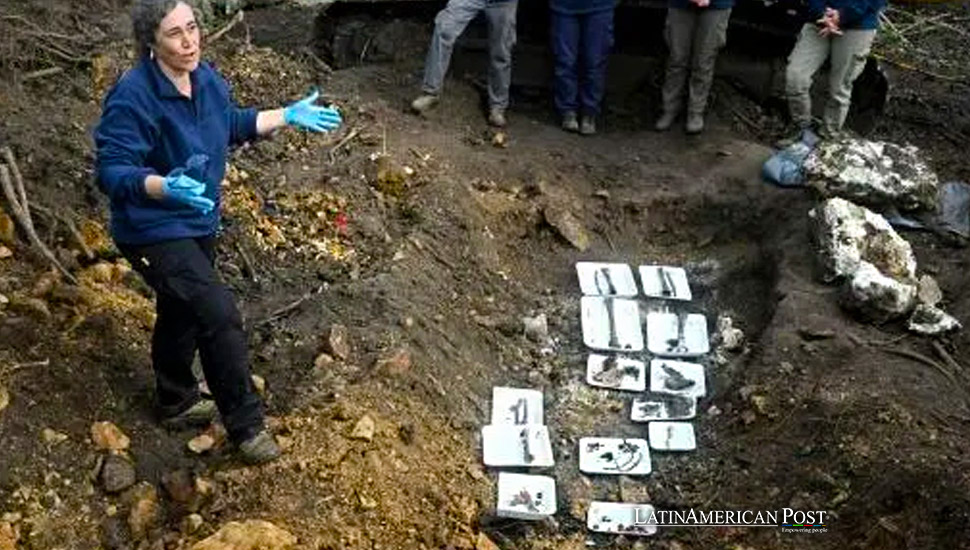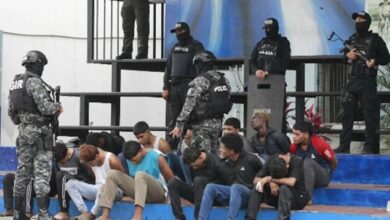Uruguay Sends Human Remains from Dictatorship to Argentina for Identification

The recent discovery of human remains in Uruguay, likely from the dictatorship era, underscores the ongoing quest for justice. The remains have been sent to Argentina for advanced forensic analysis, highlighting the cross-border efforts to identify victims and bring closure to their families.
On July 30, 2024, forensic anthropologists from Uruguay’s Grupo de Investigación en Antropología Forense (GIAF) unearthed human remains at the Batallón de Infantería Paracaidista 14 in Toledo, just outside Montevideo. The discovery, likely linked to one of the many victims of Uruguay’s military dictatorship (1973-1985), marks a significant step in the nation’s long-standing efforts to confront its dark past.
The remains were found during an ongoing excavation at a site already notorious for previous discoveries of disappeared persons, including the remains of Julio Castro, Ricardo Blanco Valiente, and Amelia Sanjurjo in 2011, 2012, and 2023, respectively. This latest find has rekindled the hopes of families still searching for answers about their missing loved ones.
A sample from the remains has been sent to Argentina, specifically to the Laboratory of Forensic Genetics of the Argentine Forensic Anthropology Team (EAAF) in Córdoba, to ensure accurate identification. This internationally recognized laboratory specializes in analyzing highly degraded and historical bone samples. The decision to send the sample to Argentina reflects the close collaboration between Uruguay and Argentina in the pursuit of truth and justice for the victims of military dictatorships in the region.
Uruguay’s Dark History: The Dictatorship Era
The military dictatorship that ruled Uruguay from 1973 to 1985 was one of the most repressive regimes in Latin America. During this period, the government employed widespread violence and intimidation to suppress any opposition. Thousands of Uruguayans were detained, tortured, and forcibly disappeared as the military sought to eliminate all forms of dissent.
The dictatorship’s tactics were brutal and systematic. Detainees were often held in secret locations, subjected to inhumane conditions, and denied any form of legal recourse. Families of the disappeared were left in a state of perpetual uncertainty, unable to obtain any information about the fate of their loved ones.
Even after the dictatorship ended, Uruguay struggled to accept this dark chapter in its history. The transition to democracy was marked by efforts to move forward without fully addressing the crimes of the past. The “Ley de Caducidad,” a law passed in 1986, effectively granted amnesty to many of the perpetrators of human rights abuses during the dictatorship. Although this law was partially repealed in 2011, it left a legacy of impunity that has complicated the search for truth and justice.
The discovery of remains like those found in Toledo is crucial to Uruguay’s efforts to confront its past. Each new find adds to the body of evidence documenting the atrocities committed during the dictatorship, providing a clearer picture of the scale of the repression and the identities of its victims.
Why Argentina? The Role of Forensic Anthropology
The decision to send the remains from Toledo to Argentina for forensic analysis highlights the importance of international cooperation in human rights investigations. The Laboratory of Forensic Genetics at the EAAF in Córdoba is one of the few facilities in the world equipped to handle the complex task of identifying remains buried and degraded for decades.
The EAAF has a long history of working on cases of forced disappearances, not only in Argentina but across Latin America and beyond. The laboratory’s expertise in analyzing highly degraded samples has made it a global leader in the field of forensic anthropology. By comparing the genetic profile of the remains with the genetic data bank of families of the disappeared, the EAAF can provide conclusive identifications that bring closure to grieving families.
In Uruguay, the work of forensic anthropologists has been instrumental in uncovering the truth about the dictatorship’s human rights abuses. The GIAF, in collaboration with international partners like the EAAF, has played a crucial role in locating and identifying the remains of the disappeared. Each successful identification not only provides a measure of justice for the victims and their families but also strengthens the historical record of the dictatorship’s crimes.
This collaboration between Uruguay and Argentina is a testament to the shared commitment of both countries to addressing the legacy of their military dictatorships. By working together, they are able to leverage their combined expertise and resources to achieve a common goal: the identification of the disappeared and the pursuit of justice for the victims.
The Ongoing Struggle for Truth and Accountability
The discovery of human remains in Toledo is just one part of Uruguay’s ongoing struggle to address the legacy of its dictatorship. Despite the end of the dictatorship nearly four decades ago, many of the crimes committed during this period remain unresolved. The “Ley de Caducidad” and other legal obstacles have made it difficult to hold perpetrators accountable, and the process of uncovering the truth has been slow and fraught with challenges.
However, there have been signs of progress in recent years. The partial repeal of the “Ley de Caducidad” in 2011 was a significant step forward, and the work of forensic anthropologists like those at the GIAF has brought new evidence to light. Human rights organizations and the families of the disappeared have also played a critical role in keeping the issue in the public eye and pushing for greater accountability.
The identification of the remains found in Toledo could potentially lead to new revelations about the dictatorship’s human rights abuses. Each discovery not only brings closure to one family but also contributes to the broader historical record, helping to ensure that the atrocities of the past are not forgotten.
Moreover, the discovery underscores the importance of international cooperation in human rights investigations. The partnership between Uruguay and Argentina in this case is a testament to the shared commitment across Latin America to addressing the legacy of military dictatorships and ensuring that the victims are not forgotten.
As Uruguay continues to grapple with its past, the work of forensic anthropologists, human rights activists, and the families of the disappeared remains critical. The journey towards justice is long and fraught with challenges, but each discovery brings the country one step closer to healing the wounds of the dictatorship.
The remains found in Toledo are not just a link to the past; they are a call to action for the present. They remind us of the ongoing need for justice and the importance of remembering those who were silenced during one of the darkest periods in Uruguay’s history. As the country continues to confront its past, the lessons learned will be essential in building a future where such atrocities are never repeated.
Also read: Uncovering Uruguay’s Dark Past as Dictatorship-Era Remains Found
The discovery of these remains and the efforts to identify them are a crucial part of Uruguay’s ongoing process of coming to terms with its history. The forensic analysis, the stories of the victims, and the determination of those seeking justice all play a role in ensuring that the legacy of the dictatorship is fully understood and that the victims are honored. Through these efforts, Uruguay can continue to heal and move towards a more just and equitable society.





